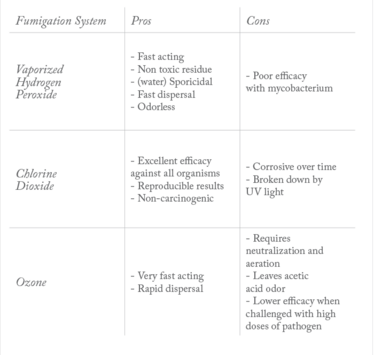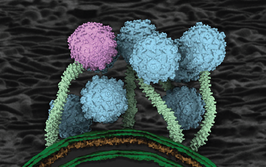
Fumigation of the Future
A choice of fumigants are available for fumigating microbiological safety cabinets and high-level containment rooms. One substance that is still used in the industry is formaldehyde, but given that formaldehyde is toxic, carcinogenic and corrosive, you’d be better looking for alternatives.
Before joining Cherwell Laboratories, I worked in the pharmaceutical sector for well over fifteen years. In that time I spent nearly six years in aseptic manufacturing and nine years as a quality control microbiologist. Those were at two different companies, but there was a common factor – both used formaldehyde as their fumigant of choice.
Formaldehyde has been used as a fumigant in laboratories since the 19th century, with one article I came across about formaldehyde dating back to 1897 (1). Older readers will remember the permanganate-formalin method of generating formaldehyde gas – this was used until fairly recently and is referenced in an article from 1913 in a review of formaldehyde fumigation (2). The health implications were recognized even then, so it is amazing to think this particular method was used for so long. Indeed, until very recently, I was still performing formaldehyde fumigations (although not using permanganate I hasten to add!).
Towards the end of my time at my previous employers, I began looking at alternatives to formaldehyde and I came up with a rational argument that I think worked well, especially when there were many members of staff set against changing the tried and tested formaldehyde fumigations. In fact, my interview at Cherwell involved a short presentation about fumigation. And now I’d like to share that rational here.
For those unfamiliar as to why rooms and equipment are fumigated; it provides an effective means of destroying micro-organisms, both in the air and on the surface, particularly when looking to destroy spore forming micro-organisms. The method of delivery depends on the chemical used and is detailed later in this article. In a nutshell, a vapor of the chemical is produced so all surfaces in the room come into contact with that chemical, therefore destroying or irreversibly inactivating any viable organisms and spores. The action is not immediate, so there has to be a certain length of contact time, which is dependent on the fumigant used. At the end of the process, the fumigant is removed; either by the room or equipment’s ventilation system, or by releasing a neutralizing agent.
Why formaldehyde?
There will be those of you reading this that still use formaldehyde to fumigate – and perhaps would never consider anything else. And then there will be those of you who have never used formaldehyde and are wondering why it’s still being used. There are two basic benefits to using formaldehyde: efficacy and cost. Formaldehyde kills pretty much all known microorganisms, which is especially important when you need to fumigate high-containment level areas. And when it comes to cost, let’s be honest, the cost of formaldehyde and a boiler is dirt cheap. Here in the UK, a 2.5-L bottle of formaldehyde can cost less than £20 (less than 25 Euros or $28) and a small boiler (although many people still use electric frying pans) is also cheap. The fumigation process is also repeatable and reliable – and it’s been used for years. If you are still using formaldehyde – and I know plenty of companies that still are – there is the obvious question of why should you change?
Well, apart from the smell and the stinging eyes when you get a whiff, and the fact that formaldehyde is a sensitizer that can cause allergic reactions, do remember that it is also identified as a class 1 carcinogen (3) by the World Health Organization’s International Agency for Research on Cancer and is highly toxic. And then there is the paraformaldehyde residue that remains post fumigation – frequently stuck hard to the surface. I hated cleaning up after formaldehyde fumigations; it takes a long time to clean and can also remain in your room’s HEPA filters for a considerable time afterwards, which can mean a long down time for your facility – definitely not the way to go in today’s competitive industry (the less downtime the better). In short, formaldeyhde is toxic, carncinogenic and corrosive. I believe that’s a good enough reason for any company to consider changing their fumigation process. Its use is not standard practice in all countries, but it’s still fairly common in Europe, particularly for small companies. In the medium to long term, however, there is a reasonable possibility that you won’t be able to use formaldehyde for fumigations at all in Europe, even if you wanted to.
Formaldehyde Facts
- Formaldehyde was accidentally produced by Alexander Mikhailovich Butlerov in 1859; it was more formally discovered in 1868 by August Wilhelm von Hofmann.
- Formaldehyde is still commonly used by pharma companies in various countries. It has intrinsic anti-bacterial and preservative properties – and is also cheap.
- As well as being used for fumigation, formaldehyde is also used to manufacture certain viral and bacterial vaccines, and has other applications in medicine and healthcare too.
- When using formaldehyde, the highest risk to health is when it is inhaled; it is generally only considered dangerous to those who routinely use it as part of their jobs.
- In the European Union, formaldehyde is banned from use in certain applications (preservatives for liquid-cooling and processing systems, slimicides, metalworking-fluid preservatives, and antifouling products) under the Biocidal Products Directive.
- In the US, formaldehyde used to be well used, but is seen as not acceptable today. In 2011, the US National Toxicology Program (NTP) declared today formaldehyde causes cancer in humans.
- Formaldehyde is not just used by the pharma industry – it’s also used in the construction, automotive and furniture industries.
The fumes of change
Within Europe, formaldehyde is currently registered as a biocide as per article 95 of the Biocide Products Regulations (4). It is costly for chemical manufacturers to register formaldehyde as a biocide and as fewer companies use formaldehyde, it will eventually no longer be cost effective to produce formaldehyde for that purpose; therefore, fewer companies will bother registering it. There are also some countries in the EU that want formaldehyde removed from the list completely because of its potential hazards. If that happens, it will be difficult to justify the use of formaldehyde as a biocide at all.
Another reason as to why formaldehyde’s use for fumigation may be limited are due to the EU’s REACH (Regulation, Evaluation, Authorization and restriction of Chemicals) regulation – which was discussed in a recent issue of The Medicine Maker (http://tmm.txp.to/0116/reach). There may come a point in the future under REACH when the disposal of formaldehyde will be even more strictly regulated; most likely the release of formaldehyde into the air or into sewerage will be banned. At this point the use of formaldehyde in fumigations will become extremely problematic, to put it mildly.
Admittedly, you can neutralize formaldehyde by passing air through carbon granules or by boiling off ammonia, but do you really want to be handling large volumes of ammonia, or having to arrange for the disposal of carbon granules saturated with formaldehyde? In both cases you will have to prove that you have completely removed the formaldehyde from the air in that cabinet or room. In the case of neutralization with ammonia, you also have to ensure the ammonia has dispersed, which could add to the already lengthy downtime that formaldehyde fumigation requires. And remember, ammonia is classified as both an irritant and corrosive, so it may not be appropriate for use in your facility.
I’m not going to commit to a timeframe as to when any of this may happen. However, if you’re using formaldehyde (wherever you are) then I recommend you read up on your respective regulations and to be prepared for change. It would also be prudent to have a plan in place to validate an alternative system sooner rather than later. Obviously, the EU regulations I’ve mentioned only apply to Europe. For those of you in the US or other areas, I’m not an expert and I’m not qualified to comment on other geographies so I encourage you to check your country’s own regulations to find out if you can or can’t use formaldehyde – and even if you can, it doesn’t change the fact that it’s a carcinogen.

Table 1. Alternatives to formaldehyde.
What’s the alternative?
Before I go through the alternatives to formaldehyde, it’s important to point out that what you choose depends on what the purpose of the fumigation is. There will be two main reasons for fumigation: to lower the bio burden in that area, such as in a cleanroom; or to destroy known pathogens due to a spillage or post maintenance shutdown in high-containment level facilities. I cannot sugar coat the fact that alternative systems can be considerably more expensive than formaldehyde – the greatest expense will be the setup cost if you are doing the fumigation in-house, which will be the case if you fumigate on a regular basis. If you fumigate on a less regular basis, it could well be worth considering the use of a contractor to do the work for you.
The following is a brief outline of each alternative technology; the details of each one are separate articles on their own. Your current options are hydrogen peroxide, chlorine dioxide and ozone, which have all been tested for efficacy against a range of pathogens by the Health and Safety Laboratory (4).
The best established of these alternatives is hydrogen peroxide and there are two main types: dry and wet. The dry version is better known as vaporized hydrogen peroxide (VHP). The mode of action requires the concentration of VHP to be maintained below the condensation point. The wet version spreads a layer of hydrogen peroxide onto exposed surfaces. Chlorine dioxide and ozone are true gas systems, as both are gaseous at room temperature.
As previously mentioned, the fumigation method needs to be appropriate to the work performed at your facility. All methods come with their pros and cons, and some claim greater efficacy than others (see Table 1). Some may be more corrosive and some will have limited penetration. Hydrogen peroxide, for instance, has limited efficacy against certain pathogens. Since the quoted study (5), there are now hydrogen peroxide based disinfectants with additional chemicals to make them more efficacious. These include the addition of peracetic acid or silver cations, which claim enhanced efficacy for different reasons.
Whichever method of fumigation you choose, do make sure that it is validated to the standard you require, whether against a particular pathogen, or by reducing the bio burden in that area by a specified amount. The method needs to be repeatable and reliable. Do also consider the cost and efficiency of the chosen system, not just the setup costs, but the down time of your facility as a result of the fumigation process too. The shorter the fumigation process, the sooner your facility will be back in action.
Andrew Ramage is Microbiology Product Specialist at Cherwell Laboratories, UK.
- S. Burrage, “Fumigation with Formaldehyde,” Public Health Pap. Rep., 23, 110-113
- (1897).
- W. Dreyfus, “Review of Formaldehyde Fumigation,” Am. J. Public Health (N Y), 4(11), 1046-1049 (1914).
- World Health Organization, “Agents Classified by the IARC Monographs, Volumes 1-115. Last accessed March 2016. bit.ly/PLEkq0
- European Chemicals Agency, List of active Substances and Suppliers (February 2016). bit.ly/1rcNnkZ
- A. Beswick A et al., “Comparison of Multiple Systems for Laboratory Whole Room Fumigation,” Applied Biosafety 16(3), 139-157 (2011).
Andrew Ramage is Microbiology Product Specialist, at Cherwell Laboratories, Bicester, UK.



















